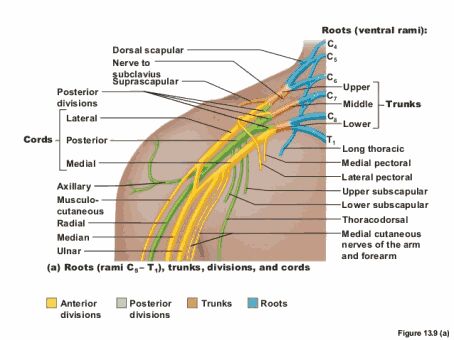BRACHIAL PLEXUS
THE BRACHIAL PLEXUS
INTRODUCTION
This is a major source of the nerves of the upper limbs. Its origin is from the ventral primary rami of the 5th, 6th, 7th, 8th cervical nerves and a large part of the 1st thoracic nerve (these are the roots). The roots run down uniting to form the trunks. The trunk also divide to form the divisions and finally the divisions unite to form the cords and its from these that the MAJOR branches of the plexus arise- the musculotaneos nerve, axillary nerve, median nerve, radial nerve and ulna nerve.
THE ROOTS; The roots are fomed by the contribution of the ventral primary rami of C5 – C8 and T1 coming from the intervertebral foreamen. They form the five roots of the brachial plexus.the roots unite to form the trunks.
THE TRUNKS; The roots unite to form the upper, middle and lower trunk. The upper trunk is formed by the coming together of the C5 and C6 roots. The C7 stands alone to form the middle trunk. The C8 and T1 come together to form the lower trunk. They form the three trunks of the brachial plexus. The trunk passes downward and laterally to leave the neck and enter the axilla via its truncated apex- cervicoaxillary canal. The trunk then divides to form the divisions of the brachial plexus.
THE DIVISIONS; The three trunks each divide to form anterior and posterior aspects. This makes up the 6 divisions of the brachial plexus
THE CORDS; The cords are formed by the uniting of the divisions. The anterior divisions of the upper and middle trunk unite to form the lateral cord lyimg on the lateral side of the second part of the axillary artery( having contributions from the C5,C6 and C7 rami), the anterior division of the lower trunk stays on its own forming the medial cord lying on the medial side of the axillary artery (having contributions from C8 and most if not all of T1) and all the posterior divisions of the three trunks join together to form the posterior cord which lies behind the axillary artery (having contributions from all the rami). These form the 3 cords of the brachial plexus. Apart from their relation to the axillary artery we can also note that the posterior cord lies on the posterior wall of the axilla and supplies the muscles of the posterior wall of the axilla and the extensor compartments of the arm and forearm, while the lateral and medial cord supplies the muscles of the anterior wall of the axilla and the flexor compartments of the arm and forearm.
THE BRANCHES; The cords then give birth to the terminal branches. However certain branches have shown up before reaching the stage of the cords, therefore branches can be divided into the infraclavicular and supraclavicular branches
SUPRACLAVICULAR BRANCH; These are branches that arise directly from the roots and the trunks. They arise above the level of the clavicle and so the name.
Supraclavicular branches from the roots; nevre to the sceleni and crevicis longus (C5-C8),nerve to scalene muscle (C5), branch of the phrenic nerve(C5),long thoracic nerve supplying the serratus anterior at its superficial surface (C5-C7) and dorsal scapular nerve supplying the rhomboid muscles (C5).
Supraclavicular branches from the trunks; nerve to subclavius supplying the subclavius muscle and suprascapular nerve supplying the infraspinatus and supraspinatus (both nerves are from (C5-C6),
INFRACLAVICULAR BRANCHES FROM THE CORDS; These are branches that show up later along the line i.e. at the cords
Lateral cord; lateral pectoral nerve (C5-C7), musculotaenous nerve (C5-C7) and the lateral root of the median nerve (C5-C7)
Medial cord; medial root of the median nerve (C8 &T1), ulnar nerve (C7,C8 &T1), medial pectoral nerve (C8 &T1), medial cuteanous nerve of the arm (C8 &T1), and the medial cuteanous nerve of the forearm (C8 & T1)
Posterior cord; upper and lower subscapular nerve (C5 &C6),thoracodorsal (C6-C8), axillary nerve (C5 & C6) and the radial nerve ( C5-C8 &T1).


Comments
Post a Comment